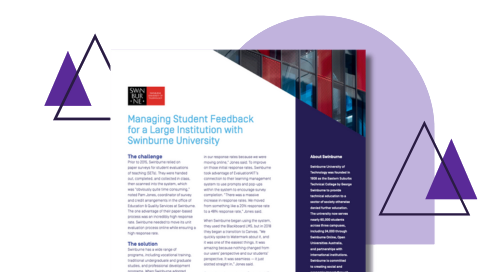Prior to 2015, Swinburne relied on paper surveys for student evaluations of teaching (SETs). They were handed out, completed, and collected in class, then scanned into the system, which was “obviously quite time consuming,” noted Pam Jones, coordinator of survey and credit arrangements in the office of Education & Quality Services at Swinburne. The one advantage of their paper-based process was an incredibly high response rate. Swinburne needed to move its unit evaluation process online while ensuring a high response rate.


Swinburne has a wide range of programs, including vocational training, traditional undergraduate and graduate studies, and professional development programs. When Swinburne adopted Course Evaluations & Surveys, they first began using it for unit evaluations in the traditional undergraduate and graduate student cohorts. Today, all 60,000 Swinburne students receive surveys through Course Evaluations & Surveys.
Over five years of use, Swinburne has identified 5 key benefits of using Course Evaluations & Surveys:
“When we first transitioned from paper surveys to Course Evaluations & Surveys, there was a slight drop in our response rates because we were moving online,” Jones said. To improve on those initial response rates, Swinburne took advantage of Course Evaluations & Surveys connection to their learning management system to use prompts and pop-ups within the system to encourage survey completion. “There was a massive increase in response rates. We moved from something like a 20% response rate to a 48% response rate,” Jones said.
When Swinburne began using the system, they used the Blackboard LMS, but in 2018 they began a transition to Canvas. “We quickly spoke to Watermark about it, and it was one of the easiest things. It was amazing because nothing changed from our users’ perspective and our students’ perspective. It was seamless — it just slotted straight in,” Jones said.
“Course Evaluations & Surveys allows respondents to complete surveys quickly and easily with their preferred device, usually their mobile phone. Our analytics show that nearly 50% of students use this method to complete their survey.”
Pam Jones, Coordinator in the Office of Education & Quality Services, Swinburne University of Technology
In addition, prompts within the LMS encourage students to complete surveys. “When you tie that in with the learning management system, you capture everybody. They can’t get away from that pop-up without completing the survey, which is brilliant. You get the responses because it’s all in the system where they’re already working,” Jones said. She believes it’s helpful to students that surveys are available within the LMS, allowing students to complete the surveys in their own time.
Increased response rates mean that Swinburne gets more, and therefore better, data to inform improvements. “Obviously, the higher the response rate, the more valid that data is that you get in from students,” Jones said. “Previously we had instances where course coordinators would say, ‘Do you really expect me to act on 15% of people’s opinion about this course?’” Now, with a nearly 50% response rate, “They say, okay, well, I’ve got to sit up and take notice,” Jones said. “So that’s been a huge success for us.”
Swinburne conducts multiple surveys each term, beginning with a check-in conducted at week four. “This survey is used to get initial thoughts on the unit and allow the conveners to make changes based on the feedback they receive,” Jones said. They leverage Course Evaluations & Surveys’ rapid reporting capabilities to get feedback to faculty immediately. “That survey closes on a Sunday at midnight, and at one minute past midnight, those reports are available for faculty to self-serve. They get a PDF with charts to break down the responses and this shows the early indication of student satisfaction. It’s very easy to interpret,” Jones said.

Data from Course Evaluations & Surveys also informs the academic promotion process. “Faculty have to have good student satisfaction scores, which hopefully therefore leads to better quality in our teaching provided,” Jones said. In addition, Jones has also set up a dashboard for deans, providing automatic access to survey results for each dean’s college.
Jones values her regular check-ins with her client success manager, which have opened her eyes to capabilities in Course Evaluations & Surveys that she hadn’t considered before. “After we’ve used something for five years, you think you know it back to front, and then all of a sudden it’s like, ‘Oh, I didn’t realize we could do that’ because we’d never looked there,” Jones said.
Swinburne has recently begun to explore other evaluations, including single-unit surveys rather than just course surveys, and has also tested live stream surveys through Course Evaluations & Surveys with faculty from the schools of science, engineering, and technology.
Jones is now testing using branching within surveys and display settings, and running surveys outside of the LMS with an anonymous link that can be shared with any respondent. “We’re testing these things because we’re picking up a lot of new skills and seeing new possibilities,” Jones said.
Watermark’s mission is to put better data into the hands of administrators, faculty, and learners everywhere and empower them to connect information and gain insights into learning that will drive meaningful improvements. Through its innovative educational intelligence platform, Watermark supports institutions in developing an intentional approach to learning and development based on data they can trust.

See how our tools are helping clients right now, get in-depth information on topics that matter, and stay up-to-date on trends in higher ed.